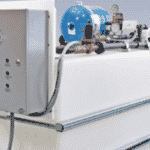Well water issues can present anything from annoying inconveniences to difficult challenges that impact your life. Understanding the differences between yield, flow rate and water pressure can help you identify the cause behind your issues.
Yield
When talking about yield, you essentially are talking about how much water your well can produce based on the source it is drawing from. It refers to the maximum sustainable rate of water that can be drawn from your well without lowering the water table below your pump’s intake valve. Yield is measured in gallons per minute (gpm) and calculated by dividing the average number of gallons discharged by the average interval, measured in minutes, between pump shut offs. A yield of between 3 and 5 gpm is considered adequate for a single-family home.
Flow Rate
Flow rate is also measured in gallons per minute and refers to how much water passes through your pipes and out your faucets or spigots at any given time. It has been calculated that the average U.S. household uses between 100 and 120 gallons per person, per day. To meet that need requires a flow rate of 6 to 12 gpm.
Water Pressure
Water pressure is the force that pushes water through your system, creating your water flow. Pressure is measured in pounds-per-square-inch (psi). The amount of water pressure you have will determine if your flow rate is weak or strong. Water pressure between 30 and 80 psi is considered normal. Pressure measuring over 80 psi could damage your appliances and may even violate building codes in your area.
What Affects Yield, Flow Rate & Pressure
Yield
A number of factors can affect your well’s yield:
- the position of the water table
- how permeable or porous your soil is
- the rate of water withdrawal
- the storage capacity of your well
There are few remedies for a low yield or low producing well. You could try digging deeper or digging a new well, but there is no guarantee these efforts will result in more water. You can also try shocking and cleaning your existing well to rid it of blockage, conserving your water usage, which is not always practical, or adding a storage tank.
Flow Rate
Your flow rate can be affected by the width of your pipes and the amount of water pressure—the force that pushes your water through your pipes and out of your faucets. Flow rate can be affected by the build up of debris, pollutants and/or minerals in your pipes as well as by the size of your plumbing system. With larger plumbing systems, it is difficult for pressure to be dispersed evenly, which can result in a lower flow rate.
Water Pressure
Water pressure issues can result from a broken pressure regulator, closed shut-off valves, clogs, leaks, as well as from a low yield or low producing well.
Well Manager Solutions for Well Water Issues
One key to resolving your well water issues is to make sure your water supply is ready when you need it most. Well Manager offers a series of products designed to ensure your water supply meets your demands – even during peak usage times – and to provide you with the best pressure possible from your low yield well. Contact Well Manager today to speak with one of our well water specialists and find the product best suited to resolving your particular well water issue.






